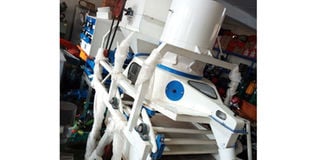Seed cleaner: Farmers can now get cleaner produce

Combined seed cleaner increases returns for maize farmers. Photos by Roland D Nasasira
What you need to know:
- Besides efficiency, the combined seed cleaner has helped smallholder farmers increase their returns, writes Roland D. Nasasira.
- Unlike the TQXY combined seed cleaner, Amooti says the TQLQ combined seed cleaner has a higher production capacity of processing up to one tonne of grains per hour while the former processes less than one tonne in one hour.
Until recently the main method of grain cleaning was winnowing. However, with the introduction of the combined seed cleaners, farmers can now save money on labour by using the machine to clean their garden produce.
One such farmer is Norbert Muhwezi, a maize farmer in Bushenyi District. He recalls that before he bought the seed cleaner three years ago, he would spend approximately Shs70, 000 daily, having to pay each labourer Shs7, 000.
At the end of the day, seven labourers would winnow about 10, 100 kilogramme bags of maize to remove stones before it was taken to the milling machine.
Production increases
The production capacity has since then increased from 10 bags to more than 100 and that this is achieved in one day using the seed cleaner.
Dan Omara, a rice farmer in Butaleja under the Butaleja Rice Farmer’s Association agrees that the seed cleaner saves farmer’s money they spend on hiring manual labour to clean rice before being packed for sale.
In Butaleja, the main method of rice drying is spreading it out on tarpaulins and cemented verandas under the sun.
In the process, it is mixed with stones and sand, which Omara says makes it cumbersome when winnowing.
“With the seed cleaner, it is easy and faster. It cleans a lot more rice in a day compared to if I hired women to winnow the rice,” Omara concludes.
Maintenance
Muhwezi says besides checking and cleaning of the seed cleaner screen to rid it of grain particles that get stack therein during the process of cleaning, the combined seed cleaner does not require much maintenance and servicing.
“I only use a wet cloth to wipe off the dust and grease the machine bearing to avoid friction which could cause machine breakdown and damage,” Muhwezi explains.
After sales service
Amooti adds that from the onset the farmer buys the machine, they are not only trained on how the machine operates but that it is also installed and fixed for them as an after sales service. It also comes with a one year guarantee and repairs in case of a mechanical breakdown or fault that may stop or hinder production.
The cost of a complete combined seed cleaner at China Huangpai Food Machines is approximately Shs25m.
The machine
Joan Amooti, the Sales Assistant at China Huangpai Food Machines at Uganda Manufacturers’ Association (UMA) showground at Lugogo in Kampala says combined seed cleaners use three-phase power and that they also come in different types.
There is the combined seed cleaner, the TQLQ Series Combined Seed Cleaner and the TQXY Combined Seed Cleaner, all of which run on the three-phase power.
Amooti notes that among the grains the machine cleans include rice, maize, sorghum, millet, among others.
And by seed cleaning, it means removing of dust, stones, metals and magnets and any other unwanted material from grains especially after harvesting. Amooti opines that seed cleaning is done before any grinding so that the end or final product of a particular grain is safe for human consumption.
“It could be the same machine that does all the cleaning work and it is just a matter of the farmer or operator changing the sieves because different grains have different sizes. It can be operated by one or two people instead of hiring 10 or more women to do the seed cleaning manually which takes a lot of time and energy and labour costs,” she says.
Unlike the TQXY combined seed cleaner, Amooti says the TQLQ combined seed cleaner has a higher production capacity of processing up to one tonne of grains per hour while the former processes less than one tonne in one hour.




